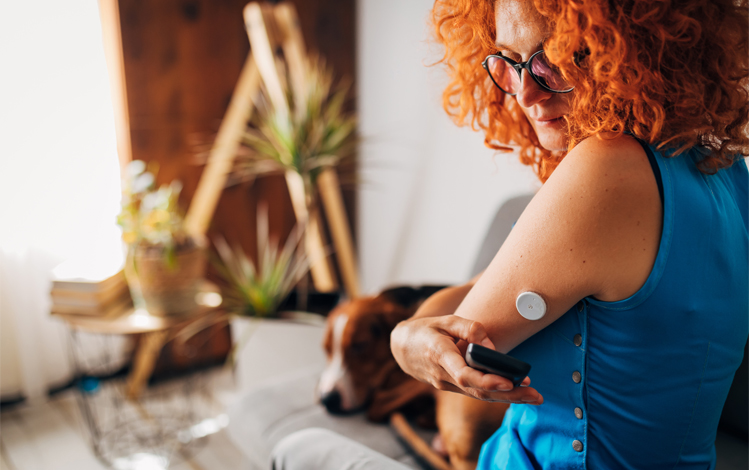

Achieving Effective Communication in the Ever-Evolving Diabetes Technology Space
Diabetes is one of the most common chronic diseases worldwide. With increased diagnosis rates, the problem has reached pandemic proportions. The number of people living with diabetes is expected to reach 642 million in 2030, more than double the 285 million cases recorded in 2010. To put these numbers into perspective, WHO estimates there have been 585 million cases of COVID-19.
Poorly controlled glucose levels can cause day-to-day problems and put patients at higher risk of long-term complications. Effective management is key to living well with diabetes, and fortunately technology can offer a helping hand. Wearable devices like continuous glucose monitors (CGMs) are painless to apply, comfortable to wear and easy to use. They have been shown to improve quality of life and reduce risk of long-term complications.
WE Communications sits at the intersection of health and technology, and our Global Health Teams have extensive experience navigating diabetes innovation and communicating its value. We are constantly assessing the diabetes tech landscape to keep abreast of new communications challenges and deliver cutting-edge programs for our clients.
In this post, we’ve provided four insights into the diabetes space, based on our experience and WE’s recent Brands in Motion research, and outlined how brands can navigate these challenges to move people to positive action.
Diabetes Burnout
WE’s Brands in Motion research, “The Healthcare Mandate,” found that mental health is a key issue that all healthcare brands should address. Companies working in diabetes technology are no exception. Living with diabetes requires massive lifestyle changes, and many people become overwhelmed by the relentlessness of disease management, a mindset known as diabetes burnout.
At its worst, diabetes burnout can lead to people ignoring their need for treatment or self-management altogether. Effective communication with, and education for, people living with diabetes on mental well-being could help combat diabetes burnout and ultimately help them avoid long-term complications.
Diabetes UK is a patient group setting an excellent example. Its “Future of Diabetes” report identified emotional and psychological health as key to improving diabetes care. Subsequently, it has produced a range of online resources to “help put things into perspective” regarding diabetes and mental well-being.
Diabetes tech companies are following suit, educating users on how wearable devices can ease the burden of disease management to support both their physical and mental well-being. WE’s Global Health teams have been supporting leaders in the diabetes space to ensure they are communicating with, educating and motivating patients to manage their diabetes physically and emotionally. By leveraging the science of behavior change, our support provokes sustained habits so patients can better handle issues such as burnout and live healthier lives.
Catering to Different Demographics
The “Healthcare Mandate” refers to the issue of health inequality and, more specifically, inequality in increasingly digitized healthcare systems. Diabetes affects a range of demographics, with different levels of digital literacy and communication preferences. To ensure equitable access to healthcare communications, companies must understand their audiences and identify their priorities.
There are three ways brands can support understanding their diverse audiences:
- Social listening: Brands must ask themselves, what conversations are happening online? What is the best way to support people living with diabetes? Gaining a deep understanding of online behaviors helps serve the community.
- Persona mapping: Although everybody is different, understanding your audiences' common factors helps you provide them with needed information and support.
- Offline research: To understand those who stay offline, identify trends outside the digital space and look to other resources such as radio and local newspapers.
The insights collected from these exercises allow brands to tell the human story behind the data. They form nuanced foundations to communication that reflect audience diversity.
Bringing the Community Together
Bringing a community together can be a very effective way to deliver a message. At WE Communications, we recognize and champion the strength of the diabetes community. In 2021, our team partnered with Novo Nordisk to celebrate the 100th anniversary of the discovery of insulin. We created a virtual escape room to share the story of insulin in a fun and engaging way, while communicating the facts. Eleven influencers with type 1 diabetes participated in the game and shared it on their social media channels, helping us circulate the content around the community.
In the context of diabetes tech, mobile apps are increasingly being used to share insights, spread awareness and influence others. The use of apps is a powerful way to engage and retain patients but also has the potential to reach and provide healthcare to a wider community.
Keeping Health Data Safe
With the help of new technology, diabetes tech brands are continuing to take huge leaps forward. The market is expected to grow from US$28.30 billion in 2021 to US$48.8 billion by 2030. Continued technological innovation promises smaller, better-connected CGMs and improvements to insulin dosing and delivery in wearable pumps. We’re already seeing how the massive amounts of data generated by these devices can be amalgamated to create a personalized glucose management ecosystem for each patient.
WE’s recent Brands in Motion report, “The Privacy Mandate,” found that 97% of consumers think data privacy is important. As diabetes tech becomes more sophisticated and the amount of data it generates increases, communication around data gathering and protection needs to become a priority. To build trust, companies need to proactively share their approach to data privacy. Communications around the issue must be part of the user experience from the very start.
At WE Communications, we work at the intersection of health and technology to help brands thrive in this ever-changing world. Our team understands the power of data and can use our heritage in the tech industry to create communications around data protection that engage and entertain users.
The latest blogs from WE
Decoding Gen Alpha: A Primer on the Next Gen of Consumers
Why Gen Alpha Will Fuel Spending This Season
Why Reputation Is a Business Driver in Healthcare



